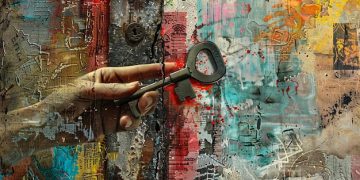Protect Your Music: Copyright & IP for Underground Artists 2025

Protecting music in the underground scene in 2025 demands a proactive approach to copyright and intellectual property, ensuring artists retain ownership and control over their creations amidst rapid digital evolution and evolving legal frameworks.
For independent artists navigating the vibrant but often volatile underground music scene, understanding how to protect your creations is paramount. The landscape of music distribution and consumption is constantly evolving, making the question of How to Protect Your Music: Copyright and Intellectual Property for Underground Artists in 2025 more critical than ever. This guide delves into the essential legal and practical steps you can take to safeguard your artistic endeavors, ensuring your hard work is recognized and respected.
Understanding the Basics of Music Copyright
Copyright law is the cornerstone of intellectual property protection for musical works. In essence, it grants creators exclusive rights to reproduce, distribute, perform, display, and create derivative works from their original compositions. For underground artists, grasping these fundamental principles is the first step toward securing your music’s future against unauthorized use.
In the United States, copyright protection for original works of authorship, including musical compositions and sound recordings, arises automatically the moment the work is fixed in a tangible medium. This means as soon as you record a demo, write down lyrics, or capture a performance, your work is technically copyrighted. However, merely having an inherent copyright isn’t always enough to deter infringement or successfully enforce your rights.
The Two Pillars of Music Copyright: Composition vs. Sound Recording
It’s crucial to differentiate between the two primary copyrights involved in music: the musical composition and the sound recording. The musical composition copyright protects the underlying music and lyrics – the melody, harmony, rhythm, and lyrical content. This is typically owned by the songwriter(s) and composer(s).
On the other hand, the sound recording copyright protects the specific performance fixed onto a physical or digital medium. This is usually owned by the artist(s), band, or record label responsible for the recording itself. Understanding this distinction is vital, especially when dealing with collaborations, samples, or cover versions, as it dictates who owns what and who can grant specific licenses.
Registering your copyright with the U.S. Copyright Office offers significant advantages. While not mandatory for copyright existence, it provides public notice of your claim, creates a legal presumption of ownership, and is a prerequisite for filing an infringement lawsuit. Moreover, timely registration allows for the recovery of statutory damages and attorney’s fees in successful infringement actions, which can be invaluable for independent artists with limited resources.
Consider these benefits of official registration:
- Public record of ownership helps deter potential infringers.
- Ability to file a lawsuit for infringement in federal court.
- Potential for statutory damages and attorney’s fees, often exceeding actual damages.
- Ability to record the registration with U.S. Customs and Border Protection for imported infringing copies.
The process for registering a copyright is relatively straightforward through the Copyright Office’s electronic registration system. It involves submitting an application, depositing a copy of the work, and paying a fee. While it might seem like an extra hurdle, it’s a small investment that offers substantial protection in the long run, particularly in a digital landscape where music can be effortlessly copied and shared.
Ultimately, a foundational understanding of what copyright protects and the dual nature of music copyrights empowers underground artists to make informed decisions about their valuable creations. This knowledge forms the bedrock upon which further intellectual property strategies can be built, ensuring artists are not left vulnerable in the face of unauthorized exploitation.
Beyond Copyright: Understanding Intellectual Property for Artists
While copyright is undoubtedly the most prominent form of intellectual property for musicians, it’s not the only one. A broader understanding of intellectual property (IP) encompasses other legal instruments that can protect various aspects of an artist’s brand, image, and unique sound. For underground artists aiming to build a sustainable career, looking beyond just copyright provides a more comprehensive shield for their creative output and identity.
Intellectual property is a collective term for creations of the mind, such as inventions, literary and artistic works, designs, symbols, names, and images used in commerce. For musicians, this can extend to their artist name, logo, album art, and even unique sound design elements that become synonymous with their artistic persona.

Trademarks: Protecting Your Identity and Brand
One of the most valuable, yet often overlooked, IP assets for an artist is their brand. This includes the artist’s name, band name, logo, or even a distinctive stage persona or catchphrase. Trademarks are designed to protect these identifiers, preventing others from using similar marks in connection with similar goods or services in a way that would confuse consumers.
Imagine building a dedicated fanbase around a unique artist name only to find someone else using it to sell music or merchandise. A registered trademark provides exclusive rights to use that mark across the country for the goods and services for which it’s registered. For underground artists, securing a trademark for your band name or stage name can be as crucial as copyrighting your songs, especially if you plan to license merchandise, tour, or pursue broader commercial ventures.
The process of trademark registration, similar to copyright, involves searching for conflicting marks, filing an application with the U.S. Patent and Trademark Office (USPTO), and fulfilling specific requirements. While a common law trademark exists simply by using a mark in commerce, a federal registration provides nationwide protection, greatly enhancing your ability to enforce your rights.
Key trademark considerations for artists include:
- Choose a distinctive name or logo that isn’t already in use.
- Conduct thorough searches to avoid potential conflicts.
- Register your chosen marks with the USPTO for maximum protection.
- Regularly monitor for unauthorized use of your brand.
Beyond trademarks, artists should also consider the protection of their trade secrets. While less common in the music industry, this could apply to unique sound engineering techniques, proprietary recording processes, or unreleased demos kept strictly confidential. Maintaining secrecy is key here, often through non-disclosure agreements (NDAs) when collaborating with others.
Understanding the full spectrum of intellectual property allows underground artists to build a comprehensive legal strategy. It’s about protecting not just the songs themselves, but the entire ecosystem of their creative and commercial identity. This holistic approach ensures that as artists gain traction, their hard-earned reputation and brand value are legally safeguarded.
Navigating Digital Distribution and Licensing in 2025
The digital age has revolutionized how music is created, distributed, and consumed. For underground artists in 2025, understanding the intricacies of digital distribution and licensing is paramount. It’s no longer enough to simply upload your music; a strategic approach to how your work is released and licensed can significantly impact both your reach and your ability to control your intellectual property.
Digital distribution platforms—from major streaming services like Spotify and Apple Music to independent platforms like Bandcamp—have leveled the playing field, allowing artists to bypass traditional gatekeepers. However, each platform has its own terms of service and licensing agreements. Artists must meticulously review these to understand what rights they are granting and what limitations are placed on their music.
Key Digital Licensing Models for Underground Artists
Most digital distribution agreements involve various types of licenses, each granting specific rights to the platform or service. These typically include:
- Mechanical Licenses: Necessary for reproducing and distributing musical compositions (e.g., through digital downloads or streams). Often handled by PROs (Performance Rights Organizations) or digital distributors.
- Performance Licenses: Required when a musical work is publicly performed, which includes digital streams, radio plays, or live performances. PROs like ASCAP, BMI, and SESAC manage these.
- Synchronization Licenses: Needed when a musical work is combined with visual media, such as in films, TV shows, commercials, or video games. This is a common revenue stream for savvy artists.
- Master Use Licenses: Required for the use of a specific sound recording in another work, such as sampling or inclusion in a compilation album.
For independent artists, choosing a digital distributor is a critical decision. These companies act as intermediaries, helping to get your music onto various streaming services and digital storefronts. While they simplify the process, it’s vital to understand their cut of royalties, the extent of rights they require, and their reporting transparency. Some distributors offer non-exclusive agreements, allowing artists more flexibility to explore other opportunities.
As of 2025, evolving technologies like blockchain for rights management are also gaining traction. While not yet mainstream for most independent artists, these decentralized ledgers promise greater transparency and immutability in tracking music usage and royalty payments. Keeping an eye on such developments could prove beneficial for future intellectual property management.
Finally, artists should be proactive in managing their master use and synchronization rights. Owning your masters provides immense leverage. Instead of signing away these rights, maintain control and proactively seek out licensing opportunities for film, television, new media, or sample clearances. This direct involvement can be a significant source of income and exposure, transforming your underground sound into something with broader appeal while maintaining creative and financial control.
The digital landscape is a double-edged sword: it offers unprecedented access but also complex challenges in protecting and monetizing your work. By understanding the nuances of digital distribution and the various licensing models, underground artists can navigate this environment more effectively, ensuring their music reaches audiences while their rights remain secure.
Enforcing Your Rights: What to Do When Infringement Occurs
Despite best efforts to protect your music, infringement can still occur. For underground artists, recognizing when your rights have been violated and knowing how to respond is crucial. Proactive measures are always best, but a clear strategy for enforcement ensures that your creative work is not exploited without consequence.
Infringement typically involves the unauthorized use, reproduction, distribution, or performance of your copyrighted music or trademarked brand elements. This can range from someone using your song in a YouTube video without permission to another artist using your band’s name or logo. The digital age has made such instances more common, but it has also provided tools for addressing them.
DMCA Takedown Notices and Cease and Desist Letters
The Digital Millennium Copyright Act (DMCA) is a powerful tool for copyright holders. If you find your music on a platform (like YouTube, SoundCloud, or a website) without your permission, you can typically issue a DMCA takedown notice. Most major platforms have established procedures for reporting copyright infringement. Filing a DMCA notice requires you to identify your copyrighted work, explain how it’s being infringed, and provide a statement under penalty of perjury that you are the copyright owner or authorized to act on their behalf.
Similarly, for broader intellectual property infringements (including trademarks and copyright), a carefully drafted cease and desist letter can be highly effective. This is a formal legal document sent to the infringing party, informing them of your IP rights and demanding that they stop the infringing activity immediately. While not a lawsuit, it signals your intent to take legal action if the infringement continues, often prompting compliance without the need for further litigation.
Steps for effective enforcement:
- Document everything: Keep detailed records of your original work, including dates of creation and registration. Gather evidence of the infringement, such as screenshots, URLs, and dates.
- Send official notices: Utilize platform-specific DMCA takedown procedures or send formal cease and desist letters.
- Consider legal counsel: If the infringement persists or involves significant financial damages, consult with an attorney specializing in intellectual property.
Monitoring for infringement is an ongoing process. Regularly search for your artist name, song titles, and unique lyrics online. Utilize tools like Google Alerts or specialized music tracking services to identify unauthorized usage. Early detection allows for swifter action and can prevent wider dissemination of infringing content.
While the prospect of legal action can be daunting for indie artists, it’s essential to understand your options. Many situations can be resolved through informal communication or a simple takedown notice. For more complex cases, legal counsel can provide guidance, assess the strength of your case, and help determine the most appropriate course of action, which may include litigation to recover damages. Enforcing your rights sends a clear message that your creative work has value and you are prepared to defend it, ultimately protecting your artistic and financial interests.
Future-Proofing Your Music: AI, NFTs, and Evolving Landscape in 2025
The year 2025 is poised to bring significant advancements and complexities to the music industry, particularly concerning artificial intelligence (AI) and non-fungible tokens (NFTs). For underground artists, proactively understanding these emerging technologies is not just an advantage, but a necessity for future-proofing their music and intellectual property.
AI’s role in music is rapidly expanding, from AI-generated compositions to AI-powered mixing and mastering tools. While these offer creative opportunities, they also raise complex intellectual property questions:
- Who owns the copyright to music generated by AI?
- How should artists address the use of their existing work to train AI models?
- What are the implications for fair use and unauthorized sampling through AI?
As of 2025, legal frameworks are still catching up to the rapid pace of AI development. Artists should be vigilant about the terms of service of any AI music tools they use, ensuring they retain ownership of their creations. Conversely, they must be aware of potential infringements by AI-generated content that may, intentionally or unintentionally, mimic their unique style or use their previous works as source material. Advocacy through industry organizations will be crucial for shaping future AI legislation.

NFTs as a New Frontier for Music Ownership and Royalties
Non-fungible tokens (NFTs) have emerged as a disruptive force, offering new paradigms for music ownership, distribution, and fan engagement. For underground artists, NFTs provide unique opportunities to:
- Directly engage with fans: Sell limited edition tracks, album art, or unique experiences as NFTs, fostering a direct relationship and bypassing traditional intermediaries.
- Create new revenue streams: Artists can set royalties into the smart contract of an NFT, earning a percentage every time it is resold on a secondary market.
- Prove authenticity and ownership: NFTs act as a verifiable certificate of ownership on a blockchain, which can be particularly useful for rare or one-of-a-kind musical pieces.
However, the NFT space also presents its own set of IP challenges. While an NFT can represent ownership of a digital asset, it doesn’t automatically convey copyright ownership of the underlying music. Meticulous drafting of NFT contracts (often called “smart contracts”) is essential to specify what rights are being transferred to the buyer (e.g., listening rights, resale rights, commercial use rights) and what rights the artist retains. Artists must ensure that their NFT sales do not inadvertently transfer their intellectual property rights unless that is their explicit intention.
The broader landscape in 2025 will likely see an increased convergence of traditional IP law with these new digital frontiers. Artists should stay informed about industry standards, best practices for blockchain implementation, and emerging legal precedents. Engaging with legal professionals who understand both intellectual property law and emergent technologies like AI and NFTs will be invaluable for navigating this increasingly complex yet opportunity-rich future, ensuring their music remains protected and profitable.
Collaborations and Contracts: Protecting Your Interests
Collaborations are the lifeblood of the underground music scene, fostering creativity and expanding artistic networks. However, without clear agreements, they can quickly become a source of intellectual property disputes. For underground artists, entering into collaborations requires a careful approach to contracts and clear communication to protect everyone’s interests.
The informal nature of many underground projects often leads to verbal agreements, which, while convenient, offer little to no legal protection. When multiple parties contribute to a song’s composition, lyrics, or recording, the default under copyright law is often joint ownership. This means all co-creators have equal rights to use or license the work, but they may also have an obligation to account to the others for any profits, which can become complicated.
Essential Elements of Collaboration Agreements
Before any significant collaboration begins, artists should consider drawing up a written agreement. This doesn’t need to be a complex legal document for every jam session, but for any track intended for release or commercialization, it’s a vital step. Such agreements should clarify:
- Ownership splits: Who owns what percentage of the musical composition copyright and the sound recording copyright? This should reflect each person’s contribution.
- Revenue sharing: How will royalties and other income from the music (e.g., streaming, downloads, sync licenses, merchandise) be divided?
- Decision-making authority: Who has the final say on creative decisions, release dates, and marketing?
- Credit: How will each contributor be credited (e.g., songwriter, producer, performer)?
- Exit clauses: What happens if a member leaves the band or collaboration? How are their contributions handled?
For bands, a band agreement is even more critical. This formalizes the structure of the group, outlining how decisions are made, how assets are shared, and what happens if a member departs. Addressing these issues upfront can prevent costly disputes down the line and ensure the band’s collective IP remains secure.
Beyond traditional collaborations, consider session musicians and producers. While they may not be co-owners of the copyright, their contributions should be covered by clear “work-for-hire” agreements or producer agreements. These contracts specify that their work on your project is owned by you (or your entity) and that they are compensated for their services rather than acquiring a share of the song’s copyright.
Even for informal collaborations, having a brief written outline of understanding, perhaps even an email exchange confirming key points, can serve as valuable documentation. The goal is to move from unspoken assumptions to clear, mutually agreed-upon terms. This proactive approach to contracts in collaborations not only protects your intellectual property but also fosters healthier, more transparent working relationships, allowing artists to focus on what matters most: creating groundbreaking music.
International Protection and Emerging Global Markets
As the digital age continues to shrink the world, underground artists increasingly find their music reaching global audiences. While the focus has often been on domestic intellectual property laws, understanding the basics of international protection and navigating emerging global markets is becoming indispensable. In 2025, a truly independent artist’s strategy must consider the worldwide reach of their creations.
The foundation of international copyright protection largely rests on international treaties, most notably the Berne Convention for the Protection of Literary and Artistic Works. The U.S. is a signatory to the Berne Convention, meaning that works copyrighted in the U.S. generally receive automatic protection in other member countries without requiring separate registration in each nation. This “national treatment” principle is a huge advantage for artists.
Key International Considerations for Artists
Despite the Berne Convention, there are nuances. Enforcement mechanisms, the duration of copyright, and specific legal interpretations can vary from country to country. For example, while copyright arises automatically, formal registration in key international markets where your music gains significant traction (e.g., Canada, UK, EU) can still offer stronger legal standing in local courts, similar to the benefits of U.S. registration.
Navigating global digital distribution also brings cross-border copyright issues to the fore. Streaming services operate globally, and ensuring proper licensing and royalty collection in various territories can be complex. Working with digital distributors who have robust international networks and understand global royalty collection agencies is crucial. Performance Rights Organizations (PROs) in your home country (like ASCAP or BMI) typically have reciprocal agreements with PROs in other countries, helping to collect international performance royalties, but it is wise to confirm scope.
Emerging markets in Asia, Africa, and Latin America present both tremendous opportunities for new fanbases and unique challenges regarding intellectual property enforcement. While these markets are rapidly developing their digital music ecosystems, piracy rates can sometimes be higher, and legal recourse may be less straightforward. Artists should be cautious about exclusive licensing deals in these regions without thoroughly vetting the partners and understanding the local legal landscape.
For independent artists eyeing a global presence:
- Research the IP laws of key target markets for your music.
- Utilize distributors with strong international royalty collection capabilities.
- Consider registering key trademarks in countries where you anticipate significant brand presence or merchandise sales.
- Engage with global artist communities to share best practices and insights on international IP.
Ultimately, a global mindset to intellectual property is about safeguarding your music as it transcends borders. By understanding how international treaties provide baseline protection, and by taking strategic steps to strengthen your rights in specific territories, underground artists can confidently expand their reach, ensuring their creative output is respected and rewarded on a worldwide scale. This vigilance prepares artists for a future where their music knows no boundaries, securing their legacy in an interconnected world.
| Key Aspect | Brief Description |
|---|---|
| 🎶 Copyright Registration | Register with U.S. Copyright Office for legal benefits like statutory damages and public record of ownership. |
| ® Trademark Your Brand | Protect your artist/band name and logo with USPTO registration to prevent identity theft. |
| ⚖️ Collaboration Agreements | Formalize ownership splits, revenue sharing, and decision-making for all joint projects. |
| 🌐 Global IP Strategy | Understand international treaties and licensing to protect your music as it crosses borders. |
Frequently Asked Questions About Music IP
▼
No, copyright protection arises automatically the moment your music is fixed in a tangible form (e.g., recorded). However, registering your copyright with the U.S. Copyright Office offers significant legal advantages, such as the ability to sue for infringement and potentially recover statutory damages and attorney’s fees.
▼
The musical composition copyright protects the underlying music and lyrics, owned by the songwriter/composer. The sound recording copyright protects the specific recorded performance, owned by the artist/label. Both are separate but equally important forms of protection for a song.
▼
You can protect your artist or band name, as well as logos, through trademark registration with the U.S. Patent and Trademark Office (USPTO). This prevents others from using confusingly similar marks in commerce and builds your brand’s legal protection and identity.
▼
First, document the infringement. Then, you can issue a DMCA (Digital Millennium Copyright Act) takedown notice to the platform hosting the infringing content. For broader IP issues, consider sending a formal cease and desist letter. If issues persist, seek legal counsel.
▼
NFTs offer new ways to sell unique digital assets and engage fans, potentially including embedded royalties. However, an NFT itself is a token of ownership for a digital file, not typically a transfer of the underlying song copyright. Carefully structured smart contracts are essential to define what rights are being conveyed.
Conclusion
Securing your music and brand as an underground artist in 2025 is a multi-faceted endeavor that extends far beyond simply creating great tunes. It requires a foundational understanding of copyright, strategic use of trademarks, diligent navigation of digital distribution and licensing, and proactive measures for enforcement. As new technologies like AI and NFTs continue to reshape the industry, staying informed and adapting your intellectual property strategy will be paramount. By taking these essential steps, you not only protect your creative output but also establish a robust framework for your artistic legacy, ensuring your hard work and unique sound are valued and respected both domestically and globally. The future of underground music depends on empowered artists who understand how to defend their art in an ever-evolving digital landscape.





